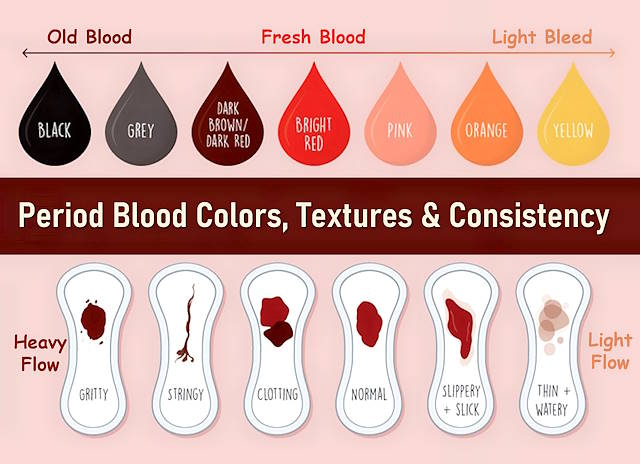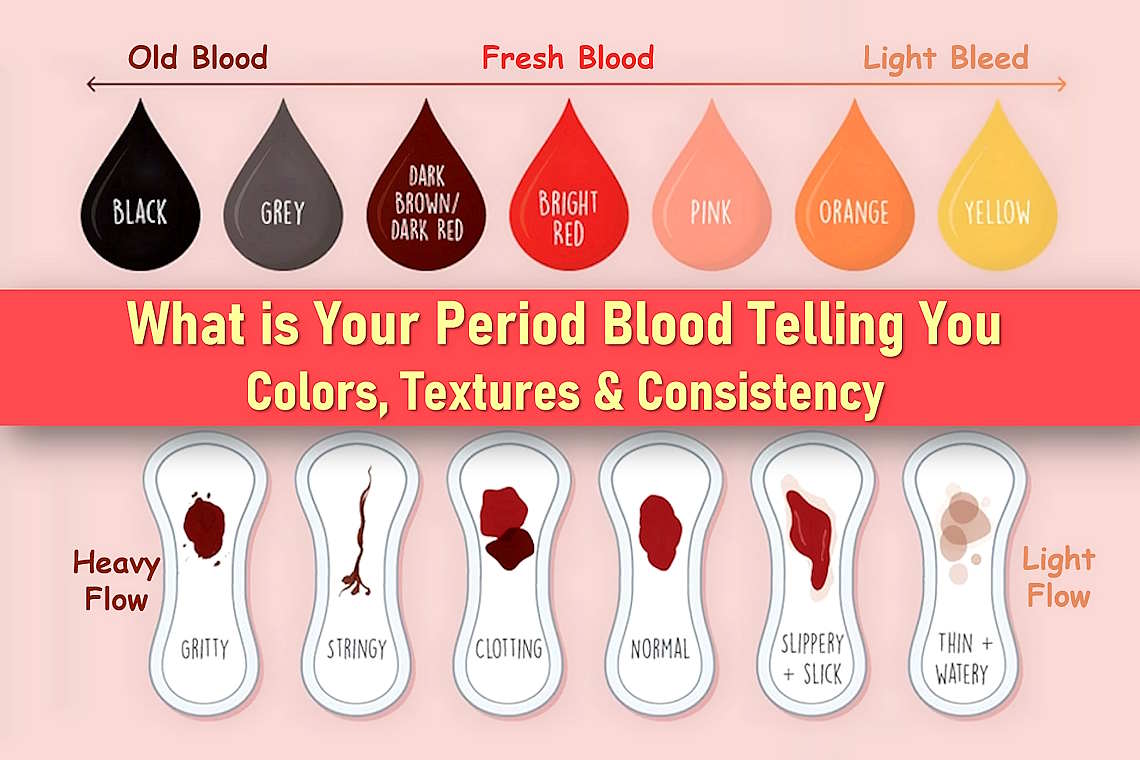What Your Period Blood Colors and Textures Can Tell You About Your Health
Your period can tell you a lot about your health. The color, texture, and flow of your menstrual blood offer important clues about your body’s condition. By understanding what different changes mean, you can become more in tune with your health and be prepared for any questions at your next OBGYN appointment. This guide will help you decode what your period blood is saying about your body.
What Causes Menstrual Bleeding?
Menstrual bleeding is a natural process regulated by hormones that fluctuate throughout your cycle. These hormones control the lining of your uterus (the endometrium). As the hormones change, the lining breaks down and sheds, causing blood and tissue to flow out of the uterus, through the cervix, and out the vagina. This is what we know as period blood.
The length and flow of your period are influenced by various factors, including hormonal changes, stress, diet, exercise, and even your overall health. So, it’s completely normal for your period to vary from cycle to cycle, but being aware of the typical changes can help you identify when something might be off.
Period Blood Colors: What Do They Mean?
It’s perfectly normal for your period blood to vary in color. The color can give you insight into how old the blood is and what stage of your cycle you’re in. Factors like your overall health, hormonal balance, and the flow of your period can influence the color of your blood. Here’s a breakdown of what different period blood colors can indicate:
Bright Red to Dark Red or Brown: Healthy Period Blood
Bright red to dark red or brown blood is considered normal. Bright red blood is usually fresh and new, while darker shades, including brown period blood, typically indicate older blood. As your period progresses, the blood flow slows down, and older blood may take longer to leave the uterus, causing it to turn brown or dark red. If you’re seeing a mix of these colors during your period, there’s no need to worry, it’s a normal part of the menstrual process.
If you notice that your period starts off bright red and gradually shifts to dark brown or brown period blood as it ends, this is completely natural. It’s simply a reflection of the speed at which your body is shedding the blood and tissue. As the blood has more time to break down, it turns darker.
Brown Period Blood: A Sign of Older Blood
Brown period blood is often a sign of older blood leaving your body. It’s common toward the end of your period when the blood has had more time to break down and mix with air, causing it to turn brown. Some people also describe brown blood as black, but this typically just means it’s been in the uterus for a while. If you experience brown discharge after period or notice brown spotting before your period, it’s usually nothing to be concerned about.
However, if brown blood is accompanied by other symptoms like unusual pain or heavy bleeding, it’s important to pay attention to these signs, as they could indicate an underlying health issue.
Pink Period Blood: Low Flow or Hormonal Changes
Light pink blood can occur at the beginning or end of your period when the flow is lighter. It could also indicate low estrogen levels, especially if it’s consistent over several cycles. If you experience vaginal dryness alongside pink period blood, it’s worth consulting your doctor. Pink spotting before your period can also happen due to hormonal fluctuations or ovulation bleeding, which is common for some people.
If you notice pink period blood for a few days at the start or end of your cycle, this is typically not something to worry about. However, if pink spotting occurs outside of your usual cycle or is persistent, it may be time to reach out to your healthcare provider for further evaluation.
Black Period Blood: A Sign of Old Blood
Black period blood usually appears when blood has had time to break down and is older. This color is common toward the end of your period, as the blood has been in the uterus longer and is exiting the body more slowly. However, if you see black blood paired with unusual symptoms like pain or a foul smell, it could be a sign of an infection, and you should consult your healthcare provider.
Grey Period Blood: A Possible Sign of Infection
Grey period blood can sometimes be a warning sign of an infection, especially if it’s accompanied by a foul odor, pain, or irritation. If you notice grey blood, it’s important to see your doctor to rule out any potential issues, such as an infection.

What Does the Texture of Period Blood Tell You?
The texture and consistency of your period blood can also provide insight into your health. Period blood is made up of endometrial tissue, and its texture can vary depending on how much tissue is being shed. Let’s look at some common textures:
Normal Period Blood: A Range of Consistencies
What’s “normal” varies from person to person, but typically, period blood will start off thicker and more clotty. As the days go on, it may become lighter and more fluid-like. Changes in the texture throughout your period are completely normal.
Watery or Thin Period Blood: Possible Causes
If your period blood is watery or thin, it could be a sign of light menstrual flow. This is most common at the beginning or end of your period, but it can also indicate stress or changes related to pre-menopause. If this texture is paired with a greyish color, it could point to an infection or another medical condition. If this doesn’t feel like your usual flow, it’s a good idea to check in with your healthcare provider.
Clots and Thick Period Blood: Common on Heavier Days
Blood clots are a common part of menstruation, particularly on the heaviest days. Thick, clumpy blood is also typically seen when blood has had more time to settle in the uterus. Darker blood is more likely to have clots, especially if your flow is slower. However, if the clots are unusually large (about the size of a golf ball or larger), you should consult your doctor. Large blood clots during your period may be a sign of underlying issues such as a miscarriage, uterine fibroids, or endometrial hyperplasia (a thickening of the uterine lining).
Jelly-like Period Blood: A Normal Occurrence
If you notice jelly-like period blood, don’t be alarmed. This texture is usually caused by cervical mucus mixing with the blood, and it’s entirely normal. This can happen throughout your period, and it’s simply a sign of your body’s natural processes at work.
Stringy Period Blood: Older Blood Leaving Your Body
Stringy period blood, often dark red or brown in color, typically signifies older blood. The stringy texture comes from blood clotting and is nothing to worry about. However, if you notice stringy blood with a heavier flow or after your period ends, it may be worth consulting your doctor to rule out any potential issues.
How Period Blood Changes Over Time
It’s completely normal for the color and texture of your period blood to change throughout your cycle. Early in your period, you may see brighter red blood as the flow is heavier and the blood is fresher. As the period continues, the flow may slow down, and the blood may turn darker or brown as it becomes older. Understanding these changes can help you track your menstrual cycle and notice any irregularities.
When Should You See a Doctor?
While occasional changes in your period blood color and texture are normal, it’s important to recognize when something might be wrong. If you experience any of the following, it’s a good idea to schedule a visit with your healthcare provider:
- Bleeding between periods
- Cycles that are significantly irregular, lasting less than 24 days or more than 38
- Missing your period for more than three months
- Bleeding during pregnancy
- Post-menopausal bleeding
- Unusual pain or discomfort during your period
Frequently Asked Questions (FAQs)
Is it normal to have brown period blood at the beginning of my period?
Yes, brown period blood at the start of your period is normal. It typically happens when the flow is slow, and older blood is leaving your body. Brown blood is just blood that has had more time to break down in the uterus.
What causes blood clots during my period?
Blood clots are common during menstruation, especially on the heavier days of your period. They form when the flow is heavier, and the blood collects in the uterus, causing clumps. While small clots are normal, larger clots may indicate a problem, like uterine fibroids or a miscarriage.
Should I be concerned if my period blood is grey?
Grey period blood could be a sign of an infection, especially if accompanied by pain, fever, or a foul odor. It’s important to visit your healthcare provider if you notice grey blood to rule out any serious conditions.
Can I have spotting between periods? Is it normal?
Spotting between periods can be normal for some individuals, especially around ovulation. However, if the spotting occurs frequently or is accompanied by symptoms like pain, it’s important to consult your doctor to rule out underlying conditions such as infections, cervical or uterine polyps, or even cancer.
How can I track the health of my period blood?
Tracking your period’s color, texture, and flow throughout the cycle can help you understand what’s normal for your body. Keeping a period journal or using an app can help identify any irregularities and make it easier to discuss with your healthcare provider.
Is it normal for my period blood to be a different color each month?
Yes, it’s completely normal for the color of your period blood to vary slightly each month due to hormonal fluctuations, stress, diet, and other factors.
Can stress affect the color or texture of my period blood?
Yes, stress can impact your hormone levels, which can in turn affect the color and texture of your period blood. For example, stress can lead to lighter or irregular periods.
Why do I sometimes experience very light or very heavy flow?
Period flow can vary due to hormonal imbalances, stress, diet, or health conditions. It’s important to track any significant changes and consult your doctor if needed.
What should I do if my period blood has a strong odor?
A strong odor, especially if it’s foul or unpleasant, could indicate an infection or other health issue. If the odor is persistent, it’s important to consult a healthcare professional.
Can changes in my diet or exercise routine affect my period blood?
Yes, significant changes in your diet or exercise habits can influence your hormone levels, which may alter the color, texture, or flow of your period blood.
Is it normal to have blood clots during my period?
Small blood clots are normal, especially on heavier flow days. However, if the clots are large or accompanied by severe pain, it may be a sign of a medical condition like fibroids or endometriosis.
Conclusion
Understanding what your period blood is telling you can be an empowering way to take charge of your reproductive health. While occasional changes in color or texture are typically nothing to worry about, it’s essential to pay attention to patterns and seek medical advice if something feels off. By being aware of your body’s signals, you can make more informed decisions about your health and ensure that any potential issues are addressed early on. Always remember, if you have any doubts or concerns, don’t hesitate to reach out to your healthcare provider for peace of mind.










